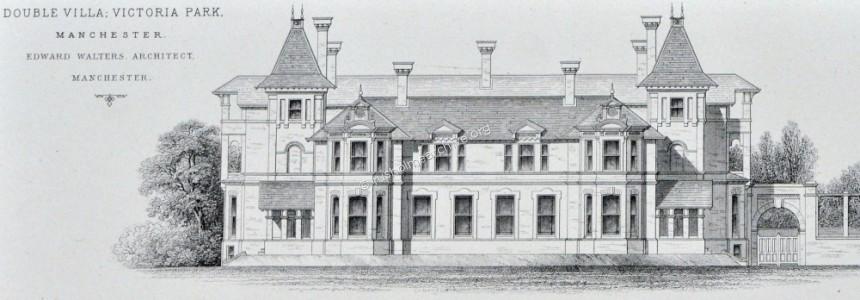Rusholme & Victoria Park Archive
James Medland Taylor, Architect (1834 -1909).
James Medland Taylor and the ‘Pepperpot’ House.
If you have looked at the page about Birch Park you may have noticed a house in some photographs, (looking north, towards Dickenson Road), which was known locally as ‘The Pepperpot’. There are two illustrations below which show the house in the background, (on the left in the first PC, and more centrally in the second).


The house that was so prominent in the background of the photographs was the home of a well-known Manchester architect, James Medland Taylor. (1834-1909).
As can be seen in these views across the park the house was clearly quite substantial and in some respects must have been quite a dominating property on the site where it was standing. Until recently I have found it frustrating not to have found information about the house, but finding a postcard, (the photograph below), with a message that clearly identified the property as being 147 Dickenson Road, Rusholme. This has enabled me to put together a memorandum of a distinguished Rusholme resident, for whom the following biographical note was published in Manchester circa 1900;
“J. MEDLAND TAYLOR, Stanford, Rusholme, and 2, St. Anne's Churchyard, Manchester. Son of Isaac Taylor, of Stanford Rivers, Ongar, Essex. Born at Stanford Rivers, 1834; educated at Leatherhead under Mr. Joseph Payne; architect; articled to Mr. James Medland, county surveyor,
Gloucester; afterwards associated with Mr. H. J. Paull, Cardiff; Mr. S. S. Teulon, London; and Messrs. Hayley and Son, 45, Cross Street, Manchester; commenced practice at 2, St. Anne's Churchyard, 1860; has been three successive years President of the Manchester Architectural Association, and two years President of the Manchester Society of Architects; chief works include numerous public buildings, parsonages, mansions, offices, factories, etc, about fifty new parish and district churches; alterations and additions to some ninety churches, including the restoration of the ancient churches at Cheadle, Radcliffe and Prestwich; and the erection of between fifty and sixty schools.”
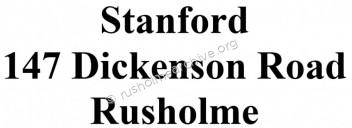
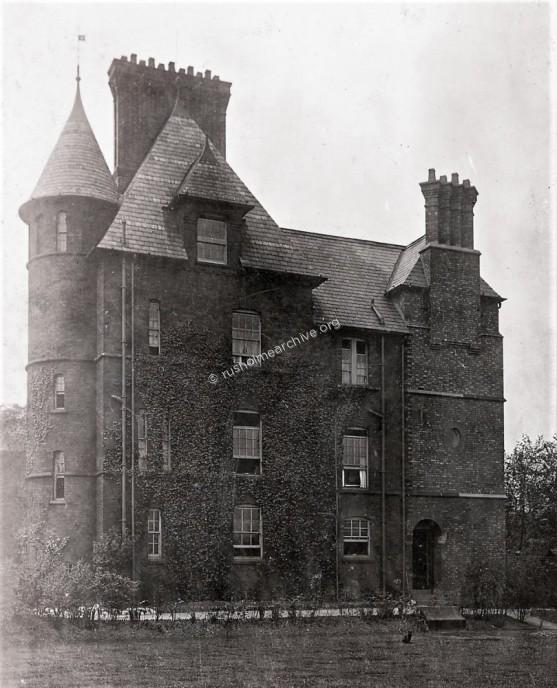
Printed below is an OS map showing the location of Stanford House on the corner of Dickenson Road and Anson Road. The house next door, Parkfield House, was for a while in the early 1900’s, the home of Sir Robert Peacock, the Chief Constable of Manchester.
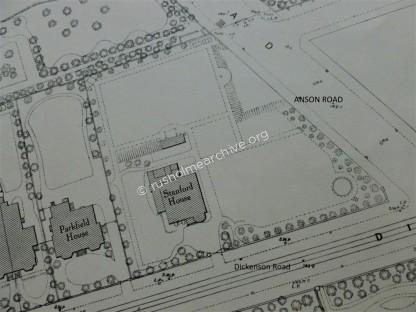
The photograph below, is a view in an easterly direction towards Longsight. The house on the corner of Conyngham Rd is the beginning of the row of large houses that culminate in Stansford. You can see the house at the end of the row by the Medland Taylor typically high chimney stack.
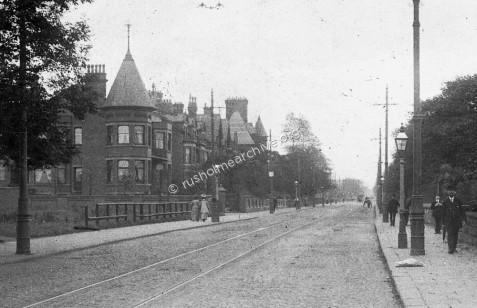
James Medland Taylor was born on the 8th June 1834 at Stanford Rivers, Essex when his father, Isaac Taylor was 46. Isaac had had married Elizabeth Medland and they had eight, (perhaps nine?) children.
James was the eldest and followed in the Medland family occupation by training with his uncle as a surveyor and architect. His younger brother, Henry, (1837-1916), was a student at Owens College, (later Manchester University) during the 1850’s and in 1860 he was joined in Manchester by his brother, James Medland, where together they established an architectural practice at No. 2 Saint Ann’s Churchyard, just off St. Ann’s Square.
In 1867 James married Priscilla Coventry and they were living at No.1 Moon Grove Rusholme when their first child, Mary Grace, was born in 1868. When James completed the 1871 census in April there were now two children, James’ 2 sisters and three servants. Whilst a modest but not a small property, No. 1 Moon Grove must have been cramped with servants and a growing family. So it was not surprising that later in the year the family moved to No.1 Birch Terrace in nearby Dickenson Road. Here they were tenants of the executors of Richard Cobden; Birch Terrace consisted of two pairs of semi-detached substantial houses built for Richard Cobden by his close friend, Edward Walters, another well-known Manchester architect. Certainly, for the size of the family and probably his successful practice No.1 Birch Terrace was an appropriate home.
(Photograph below of Medland Taylor family - not dated).
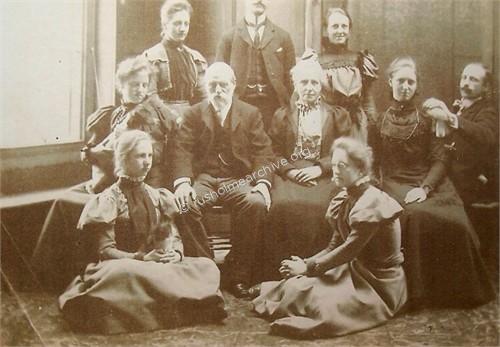
Two years later in 1873 the Rusholme Board of Health Rate books show James Medland living in 147 Dickenson Road as the owner of Stanford. Presumably the newly built home called ‘Stanford’ being named after his birthplace in Essex.
Stanford was a large house, (according to the 1911 census there 14 principal rooms). However James and Priscilla had 6 daughters and 2 boys and together with 3 or more domestic servants the space in the large house was required.
The architectural practice was clearly successful and generally remembered as ecclesiastical architects building Anglican churches. Amongst the various commissions that the practice undertook, St Anne's Church, Haughton, Denton is, perhaps considered the best example of the Medland Taylor style.
To quote from Pevsner, (author of The Buildings of England), he "Characterised certain architects as rogues, and the name has stuck. J. Medland & Henry Taylor fit the bill perfectly, though the two brothers were very different. Henry was the antiquarian, author of Old Halls of Lancashire and Cheshire, 1884. Medland was the arch-rogue of SE Lancashire, said to have been associated with one of the greatest rogues of all, S. S. Teulon, before he set up his own Manchester practice in 1860, though no-one seems to know what form the association took. It is not that the firm’s work resembles Teulon’s, but there is quirky inventiveness, a love of oddity and an element of risk-taking and willingness to experiment.”
For an explanation of the term, ‘Rogue Architecture’ J Mordaunt-Crook in his book, ‘The Dilemma of Style’ wrote the following;
Its heroes were a group of stylistic eccentrics, architectural rogue elephants, most famously William Butterfield, E. B. Lamb, S. S. Teulon, F. T. Pilkington, E. Bassett Keeling, and Thomas ("Victorian") Harris. What these six architects had in common was what musicians call "attack": a commitment to originality at all costs; and a rogue elephant energy which smashed through all the barriers of historicism. Their style was "Modern Gothic," an eclectic cocktail based on the harshest, most primitive components of Anglo-Venetian and Early French. It was an attempt to combine medievalism and modernity, traditional forms and new materials, pointed arches and plate glass. And it was popular. Rogue architecture became the demotic gothic of the 1860s.”
The postcard view below does not do sufficient justice to the architecture of St Anne’s Church, Denton, a Grade One Listed Building.
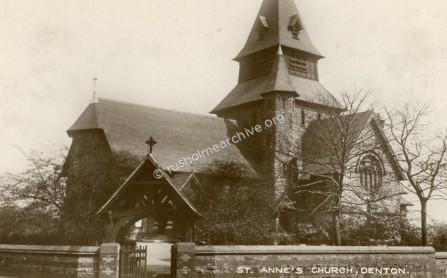
I have taken some photographs below, 2 of the church and also the Rectory – this is equally interesting to see.
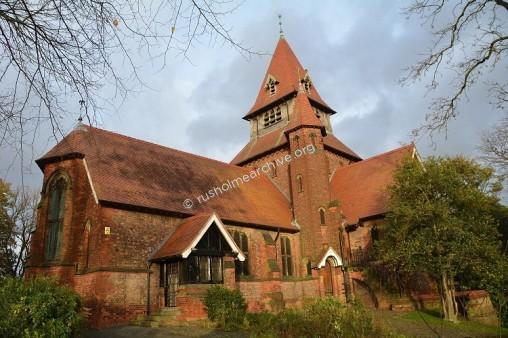
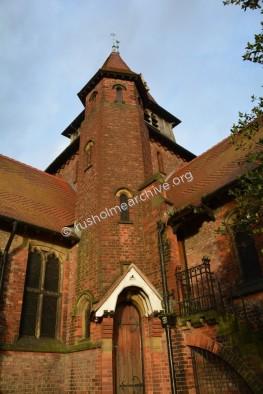
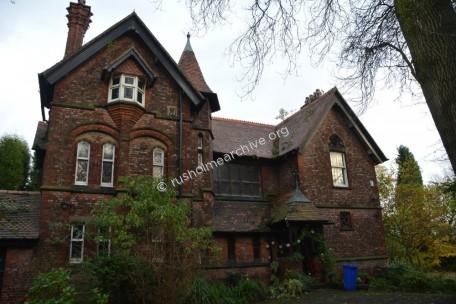
The church website offers the brief history note;
St Anne's Church in Haughton, Denton is a Grade I Listed Building. The church was built in 1881 and designed by J. Medland Taylor. The construction was funded by E. Joseph Sidebotham, a member of the Sidebotham mill-owning family of Hyde. The church was built in brick in the Gothic Revival style, but also utilised timber framing.
It has been described as the best-known work of the architects, an 'extraordinary free-form brick church that forms the nucleus of the most important cluster of their buildings' surviving. The lychgate and rectory that adjoin the main church are also of architectural significance, and each is on the register of protected buildings in its own right.
Another interesting example of their ecclesiastical work in Manchester was St Luke’s at Miles Platting. Here both the Church and alongside the Rectory show the ‘quirky’ style, sadly closed in 1975. The image below is courtesy of Manchester Libbraries m70736.
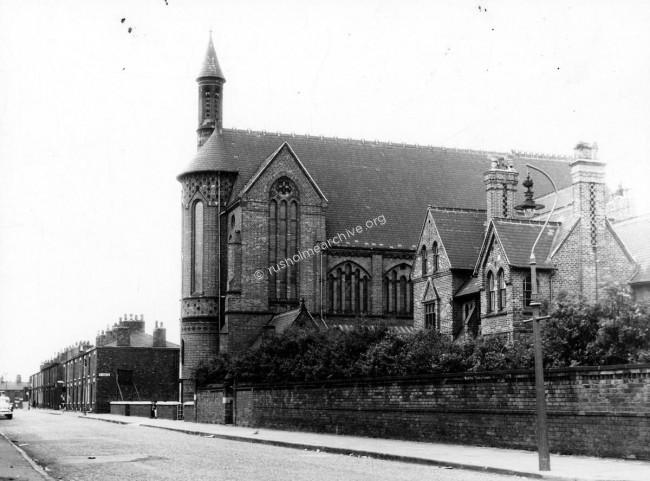
Finally, another church that Medland Taylor was responsible for, is the nearby St Agnes, Slade Lane, Longsight. Barely a mile from his own home, St Agnes was built with a modest budget of £3,000 and whilst not displaying the same degree of ‘rogue’ architecture, Pevsner describes St. Agnes as, “An amazing wilful design”. I have taken two exterior photographs that give some feeling for the church.
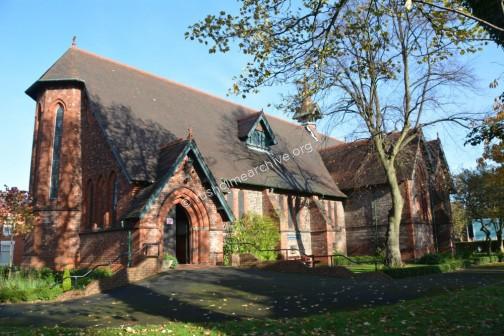
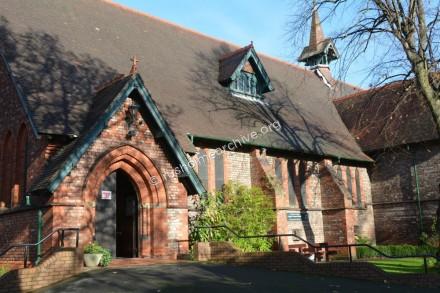
Much of their ecclesiastical work tended to be for moderately priced Anglican churches. However in 1869 they were commissioned to design the Baptist Union Chapel on Oxford Road, Manchester. This was a very large building that apparently cost £20,000. It was described as a ‘Lombardic Gothic’ style which you can see in the photograph below. In this chapel the famous Dr. McLaren preached to very large and influential congregations. You can read more about Dr. McLaren in the page The Peoples Institute
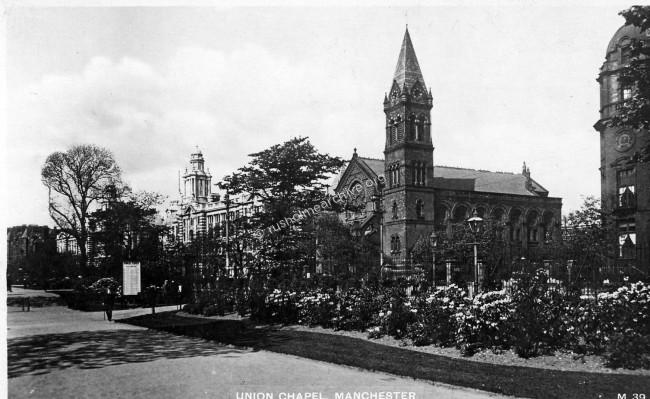
Although James and brother Henry were remembered for their ecclesiastical work they notably designed the first Board School built in Manchester. This was built in Vine Street, Hulme and opened in 1874. You can see a photograph of this in the Manchester Library Archives by clicking here,
Earlier in 1865 James and his brother had been responsible for another school at Eccles. This was the Parish School and in the press report from Manchester Guardian Aug 5, 1865 there was a reference; “The large schoolroom has an entrance at the back for the children and an elaborate gabled porch in the front, for the use of visitors and on public occasions. The architectural style is a simple type of gothic.”
The photograph below (rather in the shadow although the gabled entrance is clear) of the Eccles Parish School is reproduced courtesy of Chethams Library.
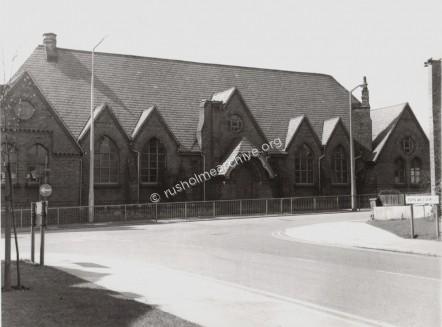
James Medland Taylor, (photograph below) died in May 1909 when he was 74; his obituary was reported in the Manchester Courier.
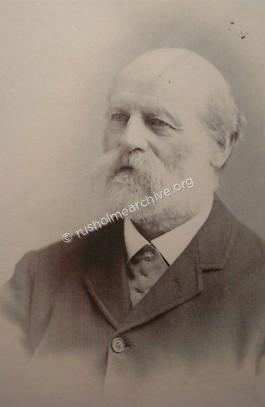
"Mr. James Medland Taylor, who has just died at his home in Rusholme, was a member of an interesting family. His father was Isaac Taylor of Stanford Rivers, Essex, the author of several books of religious philosophy. His two aunts. Ann and Jane Taylor, wrote a large number of nursery rhymes and verses, among them, “Twinkle, twinkle. little star.” His elder brother was Canon of York, and the author of “Words and Places.” Mr. Taylor himself was born in 1834 and educated at. Felstead School. He was trained in architecture in Gloucester and London; and in 1860 began his Manchester practice, which he followed until his illness, a fortnight ago. A good deal of public work was done by him. Union Chapel, Manchester: Stalybridge Public Library, and the Blair Hospital, Bolton, among other places: but he was mainly distinguished for his church work. About the Eighties of the last century, when so many of the churches of Manchester were built, he was the architect for St. Stephen's, St. Michaels and St. Gabriel's Hulme; St. Michael’s, Ardwick; St. Agnes's, Slade lane. Manchester; St. Clement's Longsight: and St. Luke’s, Miles Platting. His work was always careful, and owes much of its interest to his handling of material, and his minute attention to detail. He was generally interested in architectural art, and was an ex-president of the Manchester Society of Architects, which he joined in 1865."
His funeral was on the 4th June, 1909 at St. James, Birch, again reported in the Manchester Courier;
“The funeral took place yesterday at St. James’s Church, Birch, which he had attended for many years, of Mr. James Medland Taylor, the well- known Manchester architect. In the church, there was a choral service, which was conducted by the Rev. F. G. Buller, who was assisted by the Rev. F. W. Cooper, Rector of Prestwich. A number of members of Mr. Taylor's profession were among the mourners, one of them being Mr. Edgar Wood, president of the Manchester Society of Architects, There were also present, with others, the Rev. Canon Nunn, Professor Tout, Professor Boyd-Dawkins, Mr. H. Spafford, Mr. Taylor Smith, Mr. Frank Oakley, Councillor G K. Ashton, Mr. T. A. Bagley, Mr. T. B. Hudson, Mr and Mrs G Esdaile, Mr. A Lemaire, Mr, Turner, Mrs. Buller, Mrs. Be Steele. Mr. and Mrs. Arthur G. Edgehill, Mr. H. E. Butt, Mr. S. G. Cummings, Rev. H. D. Lockett, Rev. Canon and Mrs. Roberts, Rev. J. B. Barratt, Dr. and Mrs Delapine, Dr. Niven, Mr. and Mrs Leach, Mr. P. C. Pearson, Mr. S. Scott, the Rector and Wardens of St. Michael’s. Hulme, and Mr. Buckley. The funeral arrangements were carried out by Messrs. Kendal. Milne and Co".
Probate was granted to his widow Priscilla, his son Isaac, (a partner in the architectural practice), and two daughters Margaret and Mary. Clearly the practice had brought in substantial fees as the estate was valued at £86,163.00. Using the website ‘Measuring Worth’ a valuation at today’s figures is below;

His widow, Priscilla Taylor died in March 1923 at Stanford, the Manchester Guardian reported her death:

“Mrs. Medland Taylor, of Stanford, Rusholme, who died on Thursday night at the age of 82, came to Manchester in 1867. She was the wife of the late Mr. Medland Taylor, the architect.
Brought up among strong Conservative traditions, Mrs. Taylor showed remarkable powers of mind and character, not least in the way in which in her later years she entered into modern movements, both in religion and politics. When over 70 she became a keen supporter of women’s suffrage and during and since the war she strenuously devoted herself to efforts made to alleviate suffering especially in Russia, and the Near East.
For the last six years of her life she was blind, but she mastered Braille and type-writing, and continued almost to the last to go to concerts, lectures, and meetings, taking the liveliest interest in literature (especially Italian), music, and dancing, as well as theology.
The funeral will take place at St. James’s, Birch-in-Rusholme, on Monday afternoon."
Mrs Medland Taylor was buried at Birch on March 5th, presumably being interred with her husband. After her death the house must have been demolished fairly promptly as the row of shops, called Anson Parade was erected in 1925 on the site that Stanford occupied.
The photograph below of Anson Parade, (looking in a westerly direction), is postmarked 1950, however the tram service on the 53 route stopped running after 1930, so I think this photograph was probably taken not long after Anson Parade was built(?).
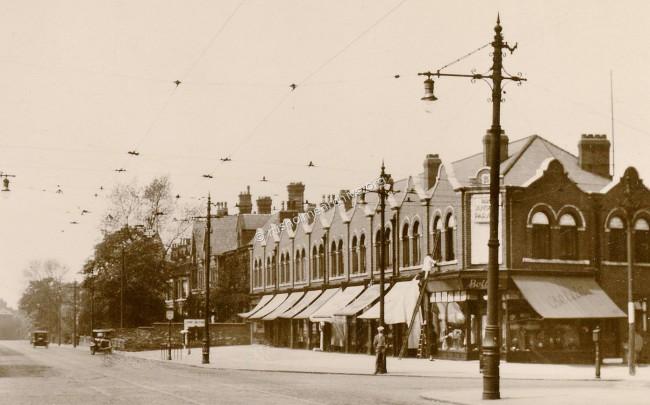
If you would like to read a more comprehensive account of Henry and James Medland Taylor you can visit the website ‘The Taylors of Ongar’
I found the three photographs that feature members of the Medland Taylor on the Ancestry website; the page in question was primarily about the family of Priscilla Coventry, the wife of Medland Taylor.
Being able to show family photographs can add so much to a story, so I really do appreciate the permission of Thomas Coventry, (who has been responsible for his family tree on Ancestry), to allow rusholmearchive.org to display the photographs.
